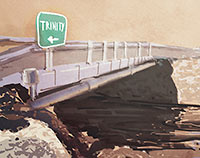COMMENT OF THE DAY: DON’T YOU DARE TAKE OUR DALLAS SEWAGE AWAY  “More and more cities (recently, San Antonio) are applying for permits to close the loop, and reuse their own treated effluent that their wastewater treatment plants previously discharged into rivers. With most cities in Texas scrambling to find more water sources, and at higher costs, this is the future. The problem is, all of the downstream cities depend on those effluent return flows for their own water systems. In the future, Houston could be going to court to try to force Dallas to keep sending its poop water down the Trinity!” [Semper Fudge, commenting on Yes, You’ve Been Sipping What Dallas Has Been Flushing] Illustration: Lulu
“More and more cities (recently, San Antonio) are applying for permits to close the loop, and reuse their own treated effluent that their wastewater treatment plants previously discharged into rivers. With most cities in Texas scrambling to find more water sources, and at higher costs, this is the future. The problem is, all of the downstream cities depend on those effluent return flows for their own water systems. In the future, Houston could be going to court to try to force Dallas to keep sending its poop water down the Trinity!” [Semper Fudge, commenting on Yes, You’ve Been Sipping What Dallas Has Been Flushing] Illustration: Lulu





Correct me if i’m wrong, but I believe that Houston will try and use the ‘rainy day’ fund $ the Leg approved for water projects to build a canal from the Trinity to Lake Houston.
If that’s the case, then 50 years from now you might be right!
Won’t every drop of water they recycle mean one less drop they have to take out of the Trinity in the first place?
Water directly harvested from “effluence” can only be used for certain things, it’s never used for drinking water since it can harm pregnant woman. It has its limitation, tho in the case of Aan Antonio, they really have no choice, they are 100 percent reliant on the Edwards Aquifer ( the largest city in the world completely reliant on an Aquifer) and the Edwards can no longer quench a region that is among the fastest growing in the nation. Houston is wise to reassess its water supply, eventhough the area gets abundant rainfall its population is going to outstrip it at some point, and you don’t want to be like San Antonio and be in perpetual stage 3 water rationing.
@Shannon,
Um you know that there has been a major national story for the last several weeks about Wichita Falls doing exactly that. A pipeline straight from the sewage treament plant to the water treatment plant and back into the drinking water supply.